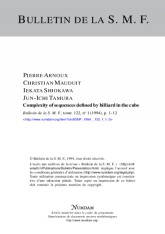Complexity of sequences defined by billiard in the cube
Complexity of sequences defined by billiard in the cube

- Consulter un extrait
- Année : 1994
- Fascicule : 1
- Tome : 122
- Format : Électronique
- Langue de l'ouvrage :
Anglais - Class. Math. : 58~F~03, 05~A~15, 05~B~45
- Pages : 1-12
- DOI : 10.24033/bsmf.2220
Nous démontrons une conjecture de Gérard Rauzy relative à la structure des trajectoires de billard dans un cube. A chaque trajectoire on associe la suite à valeurs dans $\{\mathbf {1},\mathbf {2},\mathbf {3}\}$ obtenue en codant par un $\mathbf {1}$ (resp. $\mathbf {2}$, $\mathbf {3}$) chaque rebond sur une paroi frontale (resp. latérale, horizontale). Nous montrons que si la direction initiale est totalement irrationnelle, le nombre de sous-mots distincts apparaissant dans cette suite est exactement $n^2+n+1$.

